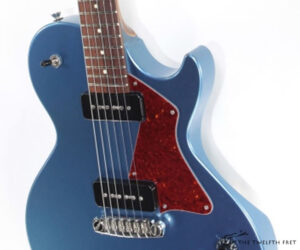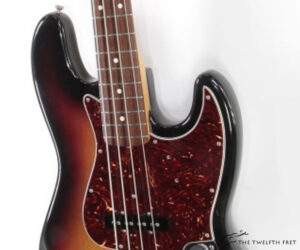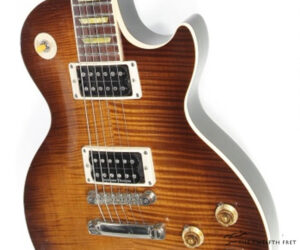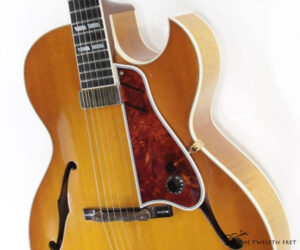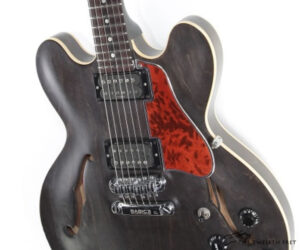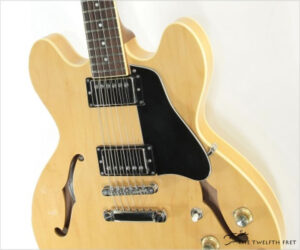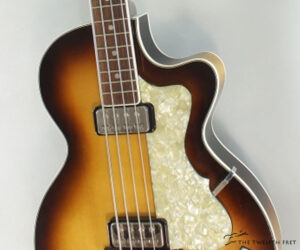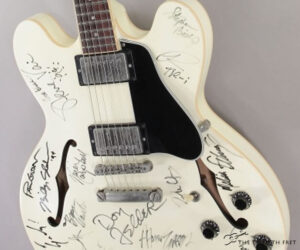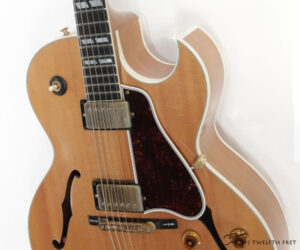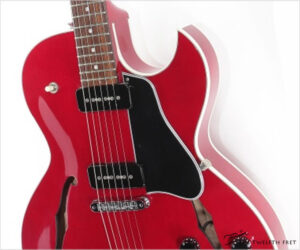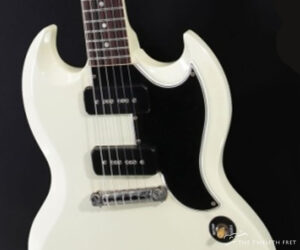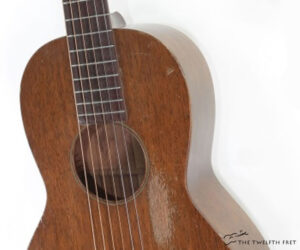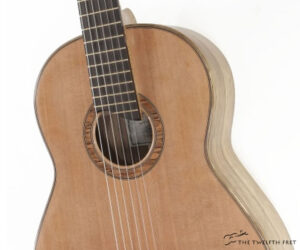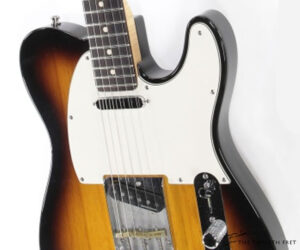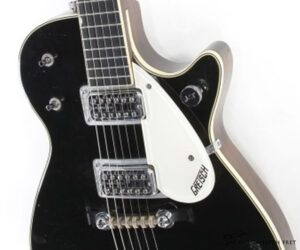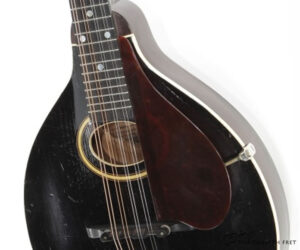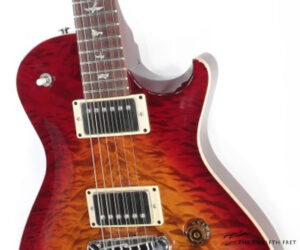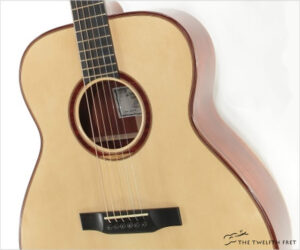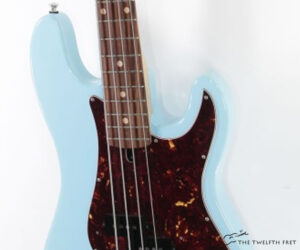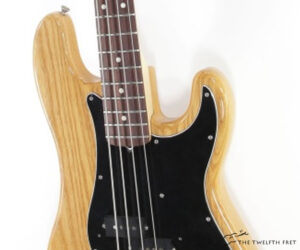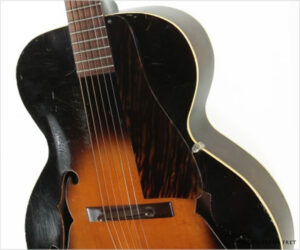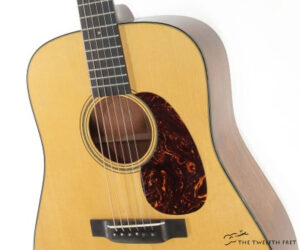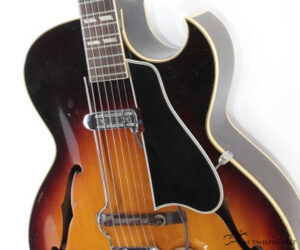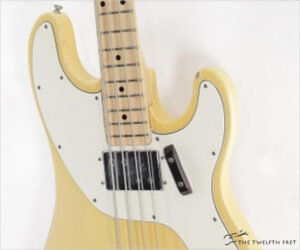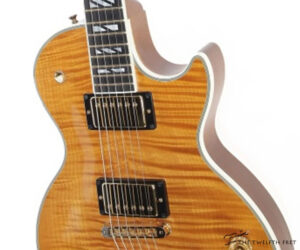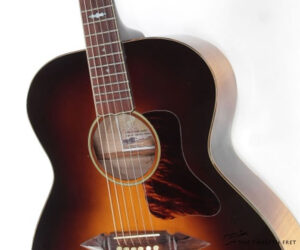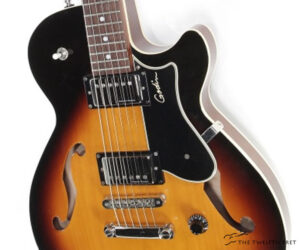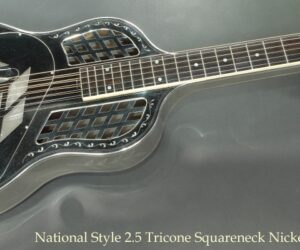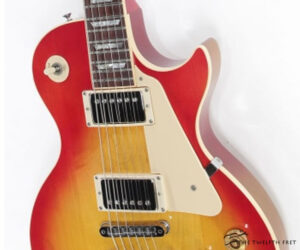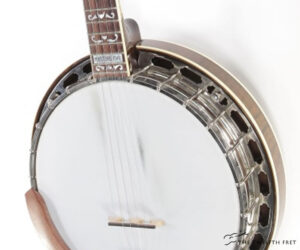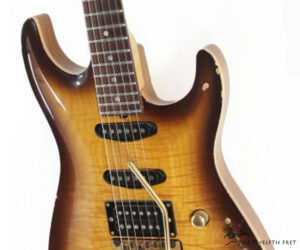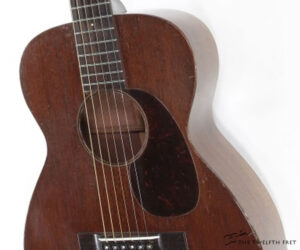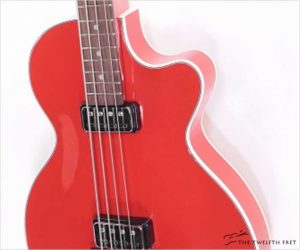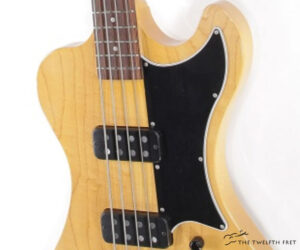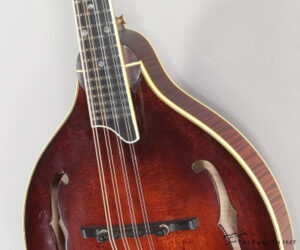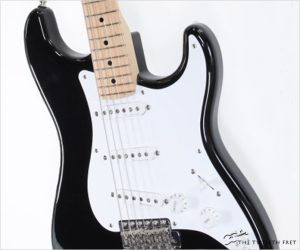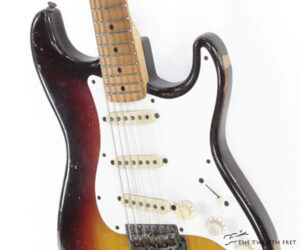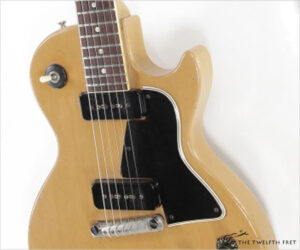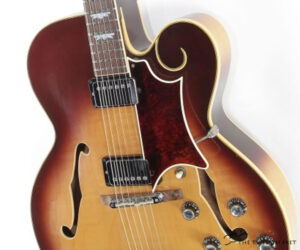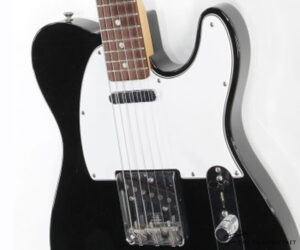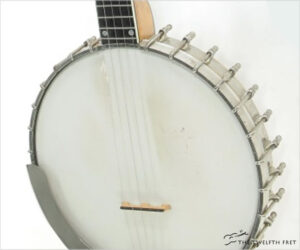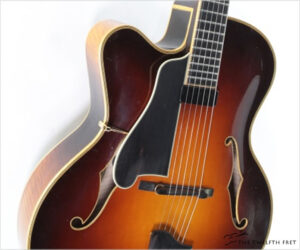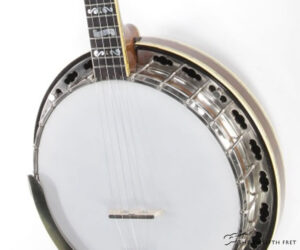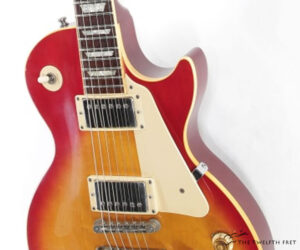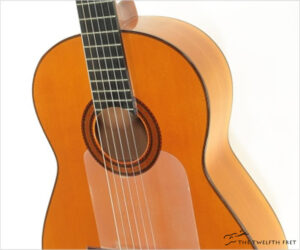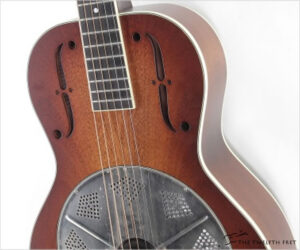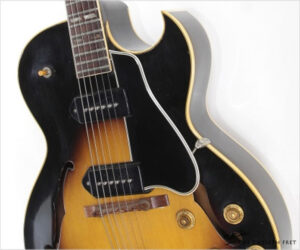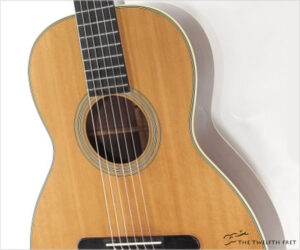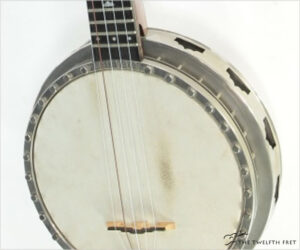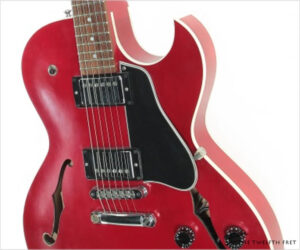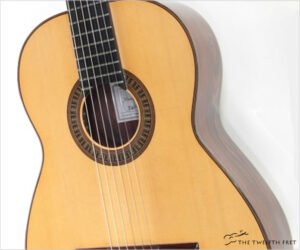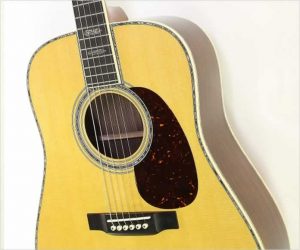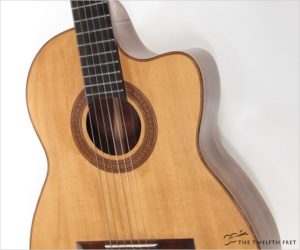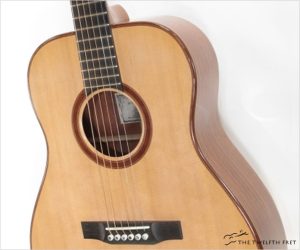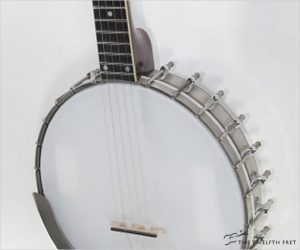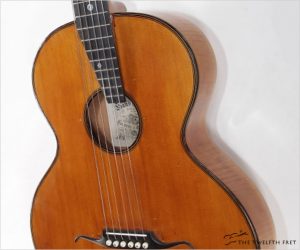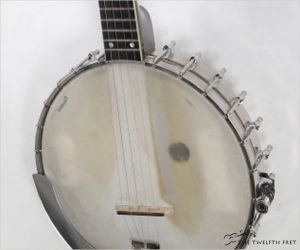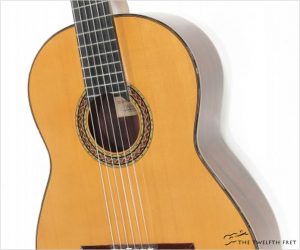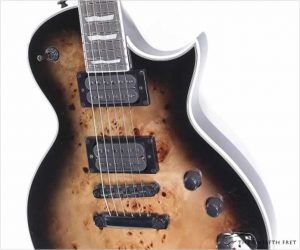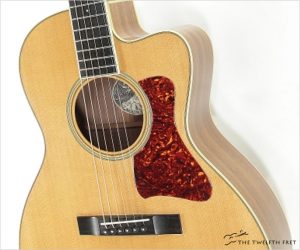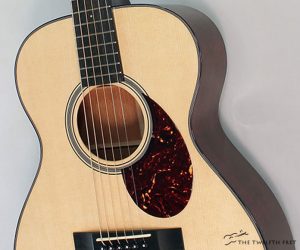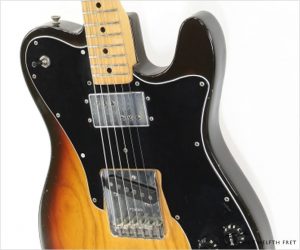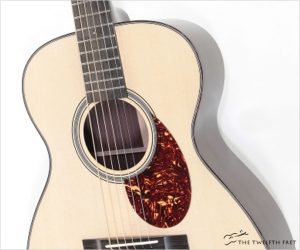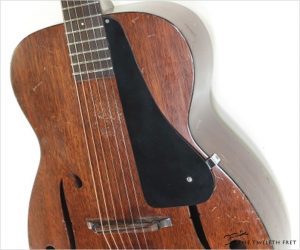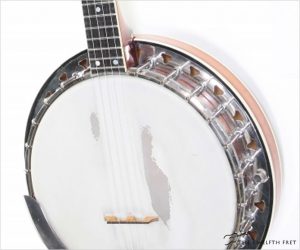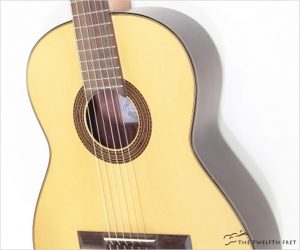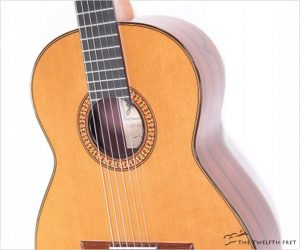While the source of the name given to this Collings 290 may seem obvious as it’s got two P90 pickups, it’s really a reference to the road outside the Collings shop. Drawing from a few traditional solidbody models, the 290 was launched in 2006 at the NAMM show, and has been in production since. Built during 2018 in Austin Texas, this Pelham Blue Collings 290 has some differences from current production.
Migrated
The Fender American Vintage ’62 Jazz Bass was built from 1999 to 2002. As part of the American Vintage series, this bass reprises the early specifications of the highly influential successor to the revolutionary Precision bass.
The Gibson Les Paul Classic Premium Plus was built from 1993 to 2001 as a high end version of the Classic, which provided the slimmer 1960 neck profile. As with other higher end Les Paul models, the body features a Mahogany back with a highly figured, bookmatched Flame Maple cap, Mahogany body and Indian Rosewood fingerboard.
When originally introduced in 1912, the Gibson L-4 appeared as a 16 inch wide, oval hole archtop, switching to F-holes in 1935. The cutaway body L-4C appeared in 1949 and by 1956 had displaced the non-cutaway model. In Gibson’s naming convention, the ‘C’ was dropped some years ago.
For 2006, the Memphis plant introduced the Gibson Satin 335, a somewhat stripped down version of the classic design. Most noticeably, the fingerboard was unbound and the finish is satin – sunburst, cherry or translucent black as seen here. Later versions seem to have restored the fingerboard binding. These models were discontinued with the Memphis plant itself in 2019.
Here is an excellent Epiphone Elitist ES-335 /NA in Natural finish, built during 2006 at the Terada plant in Nagoya, Japan. This is the same plant that builds many pro-line guitars, including Gretsch models, and this guitar illustrates the quality of their work. The Epiphone Elitist ES-335 is based on an early 1960’s Gibson ES-335 with dot position markers, but it is not an exact copy.
The Hofner Club Bass, also known as the Hofner 500/2 bass, is very similar in design to the iconic 500/1 Beatle Bass, but with a traditional single cutaway ‘Club’ body. Originally built between 1965 and 1970 for Selmer, the Club bass has had a number of prominent appearances on stages; Tina Weymouth of Talking Heads used one for several tours.
Conceived as ‘The Ultimate Signature Guitar,’ this autographed Gibson ES-335 Dot, conceived in 1991, boasts a striking Alpine White finish adorned with signatures from renowned guitarists. Originally donated by Gibson, this guitar became a centerpiece for a signature collection themed around the ‘Most Important Guitarists of the Last 10 Years,’ as chosen by readers of GUITAR Magazine in 1993.
Here we’re looking at a Gibson L-4CES (CES for Cutaway Electric Spanish) in Natural lacquer finish, dating to January 11 1989 and built at Nashville. This example is in overall very good, clean and original condition with light wear to the back finish and very light fret wear. The gold plating on the pickups shows typical wear to the bass edge, but the bridge, tailpiece and tuner plating has very little wear.
Built from 1991 to 2003 in Memphis, the Gibson ES-135 P100 was a single Florentine cutaway, semi-hollow thinline with a pair of P100 hum-cancelling pickups. From 1956 to 1958, the ES-135 existed as a renamed ES-130, a full-depth, single-cutaway archtop with one or two P-90 pickups. The ES-130 was introduced in 1954, renamed in 1956 to the ES-135, and discontinued in 1958.
The 2007 Gibson SG Special VOS replicates the 1961 style, with a pair of P90 pickups and Classic White finish. Currently this model is offered as the 1963 SG Special Classic White Ultra Light Aged. Like the SG itself, the SG Special originated as a Les Paul model, officially renamed in late 1963 at the end of Les Paul’s endorsement contract
Here we’re looking at a Martin 2-17 #25 built during early 1930 in Nazareth, Pennsylvania, showing a 1929 feature – a straight saddle. Not long after this guitar was built, Martin shifted to slanted saddles, giving the bass strings a little more length for intonation purposes. Apparently 449 were built during 1930 with this saddle, and 50 with the slanted saddle.
Seen here is a new Sergei de Jonge Classical Guitar with an elevated fingerboard, pairing a Cedar top with Black Limba for the sides, back and neck. The bracing is Spruce, the body blocks and linings are Mahogany. The bridge is Indian Rosewood and the fingerboard is Ebony. As is the case for most of de Jonge’s guitars, the finish is a hand-applied French Polish.
From 2006 at the Custom Shop, this Fender Custom American Telecaster sports a sunburst finish and a Glendale bridge plate and saddle set. The Fender Custom American Telecaster starts with a rather full, large ‘C’ profile, AAA grade birdseye Maple neck with an Indian Rosewood fingerboard, paired with a lightweight Ash body.
Here’s a fantastic piece from early 1959, a Gretsch 6128 Duo Jet in Black Top finish. Just after this guitar was built, Gretsch altered the design to add a zero fret to the fingerboard. This is a great looking, playing and sounding guitar. It is one of the lightest electrics available at just over seven pounds (3.2kg), it plays well, and these Filter ‘Tron pickups are very good sounding. Introduced in 1954 just after the solid body, Pine capped 6130 Roundup, the chambered Duo Jet was aimed directly at Gibson’s Les Paul model, with a similar shape but very different yet hidden construction differences.
Here we’re looking at a Gibson Style A ‘Snakehead’ Black-top mandolin in A-1 trim from 1927 in overall good and largely original condition. The ‘Snakehead’ term refers to the tapered headstock, an innovation by Lloyd Loar that reduced string friction at the nut. ‘Snakehead’ models were built from 1923 to 1927.
This PRS SC-245 10 Top in dark cherry sunburst is a thing of beauty, in very good clean and original condition. The SC-245 model has been in and out of production twice, from 2007 to 2009 and then 2013 to 2016.
Here we’re looking at a first-year PRS SC-245 10 Top, built during 2007 in Stevensville, Maryland. Based on the Singlecut body design, this guitar has a spectacular, highly figured bookmatched Quilted Maple top on a Mahogany back.
This Sergei de Jonge Steel String Guitar pairs a Sitka Spruce top with Padauk for the sides, back, head plate, backstrap and rosette. Built during 2018 in Chelsea Quebec, it is in very good, clean condition, and delivers a full, rich and complex sound. Like many guitars from the de Jonge shops, this model has a French Polish finish, providing protection to the woods with a minimal imposition on the guitar’s vibration.
Shown here is a Lakland USA Bob Glaub 44-64 Bass with Rosewood fingerboard and Sonic Blue finish, built during 2017 in Chicago, Illinois. Bob Glaub is a highly experienced American bassist who has long worked with Jackson Browne and many other top rank artists.
Introduced in 1951 and still in production with relatively minor changes, the Fender Precision Bass is an example of a designer getting almost everything right. Immediately, it almost completely displacing the upright bass it was intended to challenge, and it has become one of the most-used and most-recorded instruments in history.
This spectacular Bourgeois Custom D LSH Large Sound Hole, 2015- is part of a series of instruments offered around the 2015 Summer NAMM show. Dated to June 5, 2015 at Lewiston Maine, this pairs an Adirondack Spruce top with premium Brazilian Rosewood for the sides, back and head plate.
The Cromwell G-4 archtop guitar was built by Gibson from 1935 to 1939 and sold to various retailers and catalog distributors. Inside this guitar, visible through the bass F-hole is a well-preserved yellow label reading ‘New York Band Instrument Company’ indicating that it was sold by that company, at the time a large music store in New York City, but gone by 1950.
Built around February of 2015, this Martin D-18GE 1934 Golden Era Dreadnought sports an Adirondack Spruce top and a Natural finish. Martin’s Golden Era D-18 models were first built during 1995 and based on a 1937 model. From 1999 to 2016, they were based on a 1934 model, and then replaced by the Authentic series.
Seen here is a Gibson L-4C cutaway archtop acoustic guitar with an original DeArmond Rhythm Chief 1100 pickup with its ‘Monkey on a Stick’ mount. This fine vintage guitar very much looks the part, and it plays well. The 16-inch wide Gibson L-4C was introduced in 1949 and came to replace the non-cutaway L-4. That model first appeared in 1912 as an oval-hole archtop, with F-holes becoming available in 1935 and finally discontinued in 1956.
While the source of the name given to this Collings 290 may seem obvious as it’s got two P90 pickups, it’s really a reference to the road outside the Collings shop. Drawing from a few traditional solidbody models, the 290 was launched in 2006 at the NAMM show, and has been in production since. Built during 2018 in Austin Texas, this Pelham Blue Collings 290 has some differences from current production.
The Fender Telecaster Bass launched in the surprisingly late year of 1968, though its appearance is very much like the original, revolutionary 1951 Precision Bass. From a modern perspective, there isn’t a lot to the Fender Telecaster Bass.
Introduced in 2003 and built at the Nashville Tennessee shop, the Gibson Les Paul Supreme is a high-end take on the classic design and features carved, highly figured Maple top and back. The construction of the Gibson Les Paul Supreme differs from the standard Les Paul though it uses the same basic materials as the Les Paul Custom. The carved top and back set are bookmatched, highly flamed Maple, on either side of a chambered Mahogany core
Here is a rarity! A John Greven Prairie State Model ‘Doug Jones Special’ jumbo steel string from the early 2000’s. This beautiful piece is built with a Spruce top, Flame Maple for the back, sides and neck, and Brazilian Rosewood for the bridge and bound fingerboard. The binding, heel cap, head plate and pickguard are faux tortoise. Tuners are Waverly open gear models with creme plastic buttons.
Introduced in 2013 at the winter NAMM show, the Godin Montreal Premiere HT has a thin trestle-braced arched top body and is ideal for jazz players. This Godin Montreal Premiere HT example is in very good, clean condition, dates to the first months of 2016 and was built at the Godin shops in La Patrie, Quebec with a mixture of domestic and imported woods. The top, back and sides are locally sourced Wild Cherry laminate with a Trestle or ML bracing system that supports and damps the body while reducing weight, and provides anchor points for the stop tailpiece.
The National Style 2.5 Tricone Squareneck, or ‘Style Two and a Half’ is very close to the Style 2, with just a rose engraving on coverplate’s hand rest making the difference. Introduced in 1927, the Style 2 was the top of the National line, with a brass body with nickel plating. The wooden components, such as the headstock, are Mahogany, except for the Ebony fingerboard. National Resophonic guitars were a radical, major innovation in musical instrument design.
Here’s a Gibson Les Paul Standard Cherry Sunburst dating to October 22, 1980, sporting a Cherry Sunburst finish and a non-weight relieved, non-pancake body! The Les Paul model was introduced in 1952 as Gibson’s entry into the then-new solidbody ‘Spanish’ electric guitar field, where ‘Spanish’ refers to the way the guitar is held.
Built by Cliff Fitch, this is a Fitch Masters Five bluegrass style five string banjo built during 2007 near Forth Worth, Texas. It is in very good overall condition with expected play wear, and light to moderate fret wear in the low positions. Using the Mastertone 5-string concepts, the Fitch Masters Five features a figured Maple resonator covering a stained Maple rim.
Shown here is a Pensa Custom MK-1 built during 1995 in New York City by Rudy Pensa. The MK designation stands for Mark Knopfler. The original MK model was designed by Pensa and Knopfler to create a guitar capable of sounding like the 1961 Strat and 1958 Les Paul Knopfler was using on stage, allowing him to use only one guitar.
The Martin 0-17 has at least two major distinctions, as one of Martin’s oldest defined styles, and their first production steel string model. Martin’s Style 17 first appeared in 1874 as a fairly plain model, and was discontinued from 1898 to 1906.
Here’ s a new, old stock 2015 Hofner Gold Label Club Bass in solid red! The Club Bass is also known as the 500/2 – the 500/1 is the iconic violin shaped ‘Beatle Bass’. This is a ‘Gold Label’ model, one of a limited edition in custom colour. These models are built at the primary Hofner plant in Hagenau, Bavaria and are not always easy to find available for sale.
The Gibson RD Artist Bass were built during 2018, revisiting the original RD Basses from 1977 to 1981. These distinctive basses draw from Gibson’s original Firebird and Thunderbird designs, but are definitely not copies. The early RD Bass line consisted of two models, the Standard, and Artist. Construction was Maple for the body and Laminated Maple for the neck, with a Maple fingerboard.
Shown here is a beautiful Michael Heiden A-29 Deluxe A-Style mandolin, built during 2003 in Chilliwack, British Columbia. Michael Heiden has been building quality instruments since the 1970’s and his work is highly respected. Originally working in Vancouver as a musician, repairman and builder, he moved to Chilliwack and since then to Creston, B.C.
Here is a Fender ‘Blackie’ Eric Clapton Signature Stratocaster which was built during 2008 and is in great original condition. This model, introduced in 2004 and built by a team (as distinct from one master builder) features an Alder body and soft-V 22-fret, 9.5 inch radius Maple neck, with a Custom Shop logo and Clapton signature above ‘Blackie’ on the back of the head.
Showing distinct signs of having been used as intended, this Fender Stratocaster Sunburst was built during 1958 in Fullerton, California. Introduced in 1954 as the successor to the Telecaster, work on the Fender Stratocaster began in 1951.
The Gibson Les Paul Special TV model appeared in 1955, with the ‘TV’ referring to a special ‘limed’ finish intended to make the guitar more visible on black and white televisions and films. This finish had become available in 1954 on the Les Paul TV, a single-pickup Les Paul Junior. Both models used a slab Mahogany body with no Maple cap, and a Mahogany neck, with a bound Rosewood fingerboard, which into the mid 1960’s meant Brazilian Rosewood.
This Gibson Tal Farlow is a rare model. Named after the renowned jazz guitarist Tal Farlow, who played Gibson guitars throughout the ’50s where this model was designed to meet Farlow’s demands for a guitar that combined superb playability with a rich, resonant tone.
This Fender 67 Tele Closet Classic sports a period correct Rosewood fingerboard and was built during April 2005 in Corona, California. Built to original 1967 specs pairing an Ash body with an Indian Rosewood Maple neck, this guitar also includes all original style hardware – the Schaller made F-stamped tuners, Ashtray style bridge and custom shop pickups.
Combining classic D body construction and ’42’ style trim, this 2007 Collings D-42A dreadnought pairs Adirondack Spruce with Indian Rosewood. This sonic cannon delivers much more than good looks and top quality construction. Now out of production, the Collings D-42A sat at the top of Collings’ ‘Traditional’ line.
Following its original form as an A.C Fairbanks product, the Fairbanks Vega Whyte Laydie featured a natural finish on the maple neck and pot which provided its name. However, the real innovation was the Whyte Ladyie tone ring and bracket band, reducing the number of holes drilled and adding mass to the pot.
The Eastman AR910CE LH – Left Handed – is pretty much the top of the Eastman line of archtop electrics, with solid wood throughout and carved top and back. It’s fairly unusual to see an available high quality left-handed archtop. The top and its bracing are solid Spruce, paired with nicely flamed and matched Flame Maple for the sides and back.
The Deering GDL – the Greg Deering Limited – Walnut 5-string banjo sits near the top of the line for production models. It is a spectacular illustration of the state of the Banjo art. For materials, the resonator features a Burl Walnut veneer, a Maple rim and Walnut neck with bound Ebony fingerboard.
Presented here is a splendid 1993 Gibson Les Paul Standard, thoughtfully enhanced with a host of wiring and hardware upgrades. This meticulously preserved instrument retains all of its original components, while introducing noteworthy improvements.
Here is an historic piece – one of Lenny Breau’s Ramirez 1a Flamenco Guitars, built during 1961 and used during many appearances with Lenny as seen in the attached clips. The first clip is from is a CBC documentary from 1968 with Lenny playing the guitar with its distinctive friction tuners, and the visible, protective tap plates (Golpeador). Note the technical deviation from ‘strictly traditional’ Flamenco style – the use of a thumbpick, very likely a Chet Atkins influence.
Designed in collaboration with Mike Dowling, the National Mike Dowling Signature El Trovador is a single cone guitar patterned after the famous National El Trovador between 1932 and 1933. The National Mike Dowling El Trovador guitar features a large, 4 inch deep body built from mahogany laminate with a wooden soundwell for the resonator.
The Gibson ES-175D was formally introduced in 1953 as the Double P-90 pickup version of the single-pickup ES-175. Informally, a few were shipped in 1951 and 1952 but without the ‘D’ designation. This guitar came onto the scene in 1949 as a single pickup archtop with a sharp Florentine cutaway, Maple laminate body construction, Mahogany neck and Rosewood bridge and bound fingerboard.
The Martin 00-28C was the top of Martin’s classical guitar line, featuring Brazilian Rosewood back and sides and a fan-braced Sitka Spruce top. The fingerboard and bridge are Ebony, with Mahogany for the body blocks and neck. The bracing is Spruce, and the neck attachment style is a dovetail joint.
The Daniels Zither 5-String Banjo was built during the 1890’s in London England – pre-UK – by Joe Daniels using his patents for the pot and tailpiece tensioner. This fascinating instrument features a 9 inch head on a nickel plated metal rim and resonator.
The Gibson ES-135H was the ‘Humbucker’ equipped version of the ES-135, a single-cut Semi-Hollow Archtop built in Memphis from 1991 to 2004. Many of these models used P-100 pickups – a stacked humbucker with the outline of a P-90. Some models used a Trapeze tailpiece, others as seen here a standard Tune-O-Matic and Stop Tailpiece combination.
This Vicente Carrillo Pasion Flamenco Negra model, was built during 2014 in Casasimarro, Cuenca Spain where his family has built since 1744; Vicente is the seventh generation. Casasimarro is roughly between Madrid and Valencia, about 220km southeast of Madrid. Vicente Carrillo has been building instruments all his working life.
The Martin D-45 has been the top of the line in the Martin Guitar Company’s line of regular production instruments since its initial introduction in 1933, and its re-introduction in 1968.
This Bruce West Cutaway Classical guitar, bearing the serial 16-1 and built during 2016 in Sterling, Ontario features a hundred year old Swiss Alpine Spruce top and Brazilian Rosewood sides and back. Like Bruce’s other guitars, this tie into an interesting and pivotal period of Canadian luthiery history.
This de Jonge Standard Spruce and Sapele Steel String guitar with natural French Polish finish is dated to 2021. A lovely, new older stock de Jonge Standard steel string features a Sitka Spruce top with with Sapele (Entandrophragma cylindricum) for the rosette, sides, back and head plate.
This Vega Pete Seeger banjo was purchased by American composer Earl Robinson in 1966 while he was writing his ‘Concerto for Five String Banjo’. This was first performed by the Boston Pops orchestra under Arthur Fiedler. From the late 1930’s into the 1960’s, Earl Robinson composed a number of well known, largely topical pieces including ‘Joe Hill’ ‘Ballad for Americans’, ‘Black and White’ and ‘Lonesome Train’, performed by many top artists.
Here we have a Hans Raab Munich Style Guitar built of Spruce, Maple and Ebony during 1916 in Munich, Germany – during WWI. Hans Raab and his son built many instruments in a wide range of styles, from the mid 1880’s to World War II. They were well known for not just the number of instruments built and their variety – their catalog was apparently quite large – but also for the quality of their work.
The Vega Longneck Pete Seeger banjo was built from 1958 to 1970, following Seeger’s influence on the popularity of the banjo and his need to play in lower keys without retuning. This Vega Longneck Pete Seeger banjo, built during 1962 at the Vega shop in Boston is in good working order. The neck has been refinished, Capo tacks are installed, also a Presto tailpiece, with the original in the case.
Here is a wonderful rarity – a Manuel Rodriguez Sr. Classical guitar, built during 1969 in Los Angeles of Spruce, Brazilian Rosewood and flamed Maple. Manuel Rodriguez Sr. was born in Madrid in 1926 and began learning guitar building from his father, and both worked for Jose Ramirez II. Manuel opened his own shop in 1955, but in 1959 moved to Los Angeles, where this guitar, #308, was built.
The LTD EC1000 in Black Natural Burst is designed by ESP in Japan and built in Indonesia. This is a well designed and built modern take on the single-cutaway carved top solidbody guitar concept. This model uses Mahogany body with a burled Poplar top, and a ‘Set-Through’ neck joint for the 3-piece Mahogany neck.
The Collings C10 Deluxe Cutaway fits into the range of ‘Parlor’ guitars, slightly smaller than the OM or 00/000 body sizes. The cutaway is offered as an option, with the base model being a traditional non-cutaway design. The top and bracing is Sitka Spruce, the sides and back Indian Rosewood, the body blocks and neck are Mahogany and the bridge, head plate and bound fingerboard are all ebony.
The Huss and Dalton T-0014 Traditional 00 14 Fret is a spectacular guitar. The 00 body design is very well balanced and articulate, and wonderful for finger style playing. The Huss and Dalton T-0014 is built with a Sitka spruce top, mahogany back and sides, and ebony for the fingerboard and bridge.
The 1970’s Fender Telecaster Custom was a significant departure from the 1960’s Custom, which had basically been a stock model with a bound body. In contrast, the Telecaster Custom introduced in 1972 and built until 1979 introduced the head-end “Bullet” truss rod adjuster, the three-bolt MicroTilt neck angle adjuster, and a huge change for Fender – the Wide-Range Humbucker designed by Seth Lover.
The Huss & Dalton T-OO14 is a fantastic mid-size steel string acoustic guitar, based on the classic ‘OO’ body size. This design dates to 1877 as a 12-fret gut string instrument, and evolving into the steel-string, 14-fret model in 1932 as banjo players moved to guitar.
Listed from 1935 to 1941, the Martin R-17 was one of a few arched top, flat back models in the Martin catalog, featuring a Mahogany top, back and sides. Its sibling, the R-18, had a solid, shaped Spruce top with Mahogany elsewhere; Brazilian Rosewood was used for the head plate, bridge, and fingerboard. Early examples of both models used 12 fret necks but soon gained the more popular 14 fret configuration.
Here we have a Vega FW5 Folk Wonder, factory converted as new to a Vega Senator. At the time this banjo was built, the Vega name and facilities were owned by the C F Martin guitar company, and a few years later Martin built some higher end Vega banjos in Nazareth PA. The Vega name is now owned by the Deering company, who manufacture excellent Vega models.
Here is an unusual item! Built during 2014 in Guanajuato, Mexico, this is a J Perfecto Rubio Estudio model; the builder is a cousin of famed luthier German Vazquez Rubio of Los Angeles, who worked for Bernardo Rico when B C Rich models were new. We do not see many Mexican-built guitars in Canada, and in that number, high quality models like this are even rarer.
The concert-grade Ramirez Traditional Professional 1a Model is the “benchmark guitar” for tone and quality for Maestros, performers and Master-Luthiers world-wide. Considered by many to be the Ultimate Concert guitar, the traditional is available in Red Cedar top and by special order in German Spruce top. The Ramirez 1a Professional is built with Indian Rosewood back and sides. We also offer it in artist-grade Madagascar Rosewood back and sides.
